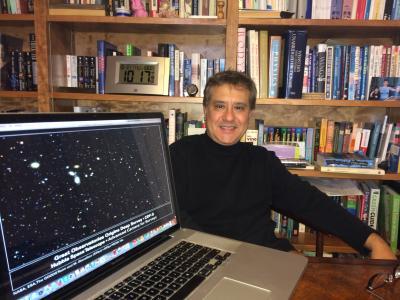AMHERST, Mass. -- In a major new survey of the early universe conducted from the NASA's Hubble Space Telescope, University of Massachusetts Amherst astronomer Mauro Giavalisco and colleagues at several other institutions identify the most distant, thus the earliest galaxy ever detected.
Although other Hubble-based observations have identified many other candidates for galaxies in the early universe, including some that may be even more distant, this galaxy is the farthest and earliest whose distance can be definitively confirmed with follow-up observations from the Keck I telescope, one of the largest on earth.
The surprise finding of a young galaxy from a survey that was not designed to find such bright early galaxies suggests that the infant universe may harbor a larger number of intense star-forming galaxies than astronomers believed possible, say first author Steve Finkelstein of the University of Texas (UT) at Austin, Giavalisco and others writing in a recent issue of Nature. This means theories and predictive models of the distribution of galaxies' star formation activity may need revision.
"We expected to find a lot more small objects with this survey," says Giavalisco. In the same way physics predicts that throwing a brick through a window should produce a huge number of small shards and very few large pieces, he adds, theory predicts there should be "many small-mass galaxies but just a few large ones. And our survey was not really designed to find these early galaxies with such a high rate of star formation. However, on the first try we see this very active object. So we're not sure if we're really, really lucky or if our predictive models are slightly off."
The high luminosity, powered by star formation activity, of this new galaxy "raise a tantalizing question about whether we've got the theory of galaxy formation correct in its fundamental ideas," the astronomer adds. "Predictions about the star formation rate distribution of galaxies are related to the physics of gas accretion onto galaxies and subsequent gas expulsion from them. These mechanisms are not yet fully understood."
The team, with researchers from Israel, Italy, Arizona, Maryland, California and Kentucky with UMass Amherst and UT, used two special cameras on Hubble as part of the largest investigation of the distant universe ever made with the space telescope.
To identify this distant galaxy from among myriads of other, closer faint galaxies that obscure deep images of the sky, they used a technique called the "Lyman-break selection" developed by Giavalisco and others in the 1990s. It exploits the apparent colors of galaxies as a crude distance indicator. "Colors encode a lot of physical processes at work in them," he points out, "such as whether they form stars or not and how much dust is in them, because dust dims stellar light and makes their colors redder."

To identify this distant galaxy from among myriads of other, closer faint galaxies that obscure deep images of the sky, they used a technique called the "Lyman-break selection" developed by Giavalisco and others in the 1990s.
(Photo Credit: UMass AMherst)
"Thanks to the Lyman-break selection, we can cull the very rare, genuinely distant galaxies from the much more abundant dust-reddened nearby ones with great confidence, making the study of the distant universe possible," he adds.
But the Lyman-break technique yields only crude distance estimates, so astronomers need to accurately determine the distance to pre-selected remote galaxies, and hence the age at which they are being observed, not only to accurately date the galaxy, but also to accurately measure its mass, luminosity and star-formation activity.
To measure the distance to this record-breaking galaxy, Finkelstein, Giavalisco and colleagues needed very sensitive spectroscopic telescopes to detect a specific spectral feature emitted by hydrogen known as the Lyman-alpha emission line. It is emitted in a very narrow range of ultraviolet wavelengths, invisible to the human eye. "But if our galaxy is really so distant from us, then the fast cosmic expansion that existed at its early days would be redshifted because of the expanding universe from its apparent wavelength to infrared wavelengths," Giavalisco points out.
To detect the Lyman-alpha emission from such a distant galaxy and fully confirm its nature, the team used the Keck 10-meter telescope in Hawaii, a very powerful spectroscopic instrument. Results yielded a redshift parameter, that is an indicator of distance, of z = 7.51, by far the most distant galaxy ever recorded. At that time the universe was only 700 million years old, compared to 13.8 billion years today. It was 8.5 times smaller than today, 600 times more dense and expanding 8.5 times faster.
Lyman alpha light is also a powerful probe of the early universe. It cannot penetrate the neutral hydrogen gas that envelops young galaxies because the gas's atoms very easily absorb it, Giavalisco says. It can, however, propagate freely through ionized gas bubbles around older, more evolved galaxies. Thus, detecting Lyman-alpha from a very early galaxy suggests that its neutral hydrogen volume is small.
"This is a very important piece of information about cosmic re-ionization," the astronomer points out. Re-ionization is a crucial phase of cosmic evolution that happened when the universe went from being a distribution of cold neutral gas with no light sources, also known as the Dark Age, to being fully ionized.
"We believe that the energy to ionize the hydrogen came from the first stars and the first quasars, which ended the Dark Age, lifted its cold fog and made the cosmos transparent to Lyman alpha light," Giavalisco says. Thus, this study moves science closer to answering a long-standing mystery about how cosmic re-ionization proceeds. If the theory of the Big Bang is correct, we must see the recombination of the ionized plasma into a neutral gas, or re-ionization."